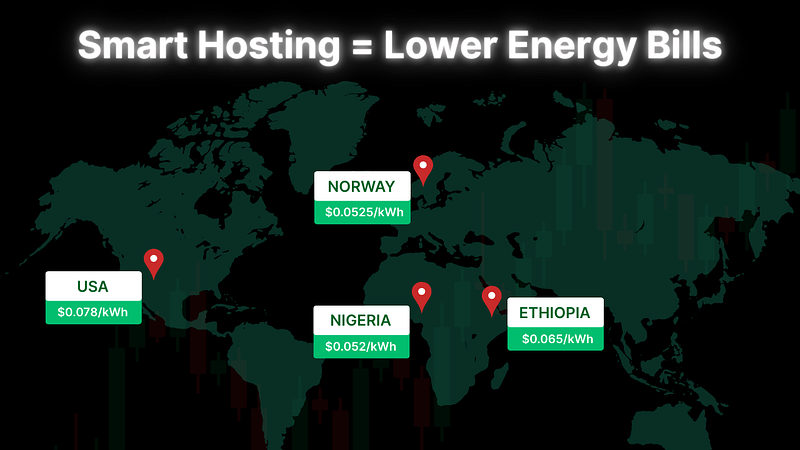Introduction: Why Electricity Costs Are the Silent Killer in Mining ⚡
When people talk about crypto mining, the first things that usually come up are hashrates, hardware specs, and block rewards. But after spending more than five years in this industry, I’ve noticed something beginner miners often overlook: electricity costs can make or break your profitability.
It doesn’t matter if you’re running the latest generation of crypto mining hardware — if your power bill is too high, your ROI can collapse before it even begins.
That’s why I want to break down what $0.04 vs $0.12 per kilowatt-hour (kWh) really means for your mining operation. Using real-world examples and tools like ASICProfit, I’ll show you how to calculate the impact and make smarter decisions about where and how you mine.
Understanding the Basics of Crypto Mining Hardware 🖥️
Before we dive into numbers, let’s make sure we’re on the same page.
Crypto mining hardware — whether it’s a Bitcoin ASIC, Kaspa rig, or Aleo miner — is essentially a machine designed to solve cryptographic puzzles. The faster it does this (hashrate), the more rewards it earns.
But here’s the kicker: these machines are power-hungry. A top-tier ASIC miner can consume anywhere between 3,000–6,000 watts of electricity nonstop. Multiply that by 24 hours, and you’ll see why electricity rates play such a big role in profitability.
Why kWh Pricing Matters More Than You Think
A kilowatt-hour (kWh) is the standard measurement for electricity usage. One kWh equals 1,000 watts consumed in one hour.
For miners, the cost per kWh is the biggest ongoing expense. Unlike hardware (which is a one-time purchase), your power bill keeps coming every day.
Here’s the simple truth I’ve learned:
- At $0.12/kWh, a single high-performance ASIC could eat up to $10+ per day in electricity.
- At $0.04/kWh, the same machine might cost only $3–4 per day.
That’s a gap of $200+ per month per machine. If you’re scaling with 10, 20, or 100 miners, the difference can be life-changing.
Real Example: S21+ Hyd at $0.04 vs $0.12
Let’s take the Antminer S21+ Hyd as an example. It consumes about 5,370W and delivers 110 TH/s.
At $0.12/kWh:
- 5,370W × 24h = 128.88 kWh/day
- 128.88 × 0.12 = $15.47/day in electricity
At $0.04/kWh:
- 128.88 × 0.04 = $5.16/day in electricity
👉 That’s a $10.31 daily difference — or about $309 per month (per machine).

Scaling the Numbers: Why Hosting Rates Change the Game 🌍
If you’re running a few machines at home, the difference is noticeable. But when you scale to 20, 50, or 100 units, it’s massive.
Example with 20 Antminer S21+ Hyd units:
- At $0.12: $15.47 × 20 = $309.40/day
- At $0.04: $5.16 × 20 = $103.20/day
- Monthly savings: ~$6,180+
That’s why hosting providers in regions with cheap power — like Nigeria, Ethiopia, or parts of the U.S. — are so appealing.
The Hidden Benefit: Shorter ROI Cycles 📈
When I started mining back in 2018, I learned quickly that ROI (return on investment) isn’t just about hardware price — it’s about how fast your machine pays itself off.
If your miner earns $20/day gross but spends $10/day on electricity, your net is only $10/day. That means your ROI is twice as long compared to someone paying only $3/day for power.
Quick Math Example:
- Miner cost: $2,000
- Net profit/day at $0.12: $10 → ROI in 200 days
- Net profit/day at $0.04: $17 → ROI in 118 days

That’s nearly a 3-month difference — just from cheaper electricity.
Why ASICProfit Helps Level the Playing Field
Manually calculating profitability is fine for one or two machines. But what if you’re comparing dozens of models across multiple coins? That’s where I rely on ASICProfit’s free calculator.
Here’s how I use it:
- Enter miner model (e.g., KS3M, S19, AE2)
- Input my electricity cost (e.g., $0.04 or $0.12)
- Get instant breakdown: gross profit, daily power cost, net profit, and estimated ROI
It saves me from messy spreadsheets and helps me quickly compare mining strategies.
If you’re serious about mining in 2025, I recommend checking it out here: ASICProfit.
Common Mistakes Beginners Make ❌
Over the years, I’ve seen many new miners lose money simply because they ignored electricity rates. Here are the top mistakes:
- Assuming profitability calculators use the same power cost as you. Always double-check!
- Ignoring local utility fees or taxes. Your real rate might be higher than the advertised one.
- Overestimating uptime. Machines don’t always run at 100% — repairs and downtime happen.
- Forgetting cooling costs. Extra fans or air conditioning add to the bill.
Pro Tips for Smarter Mining ⚡
If you want to stay profitable in today’s competitive environment, here’s what I suggest:
- ✅ Shop for energy first, hardware second. A mid-tier miner on cheap power beats a high-end miner on expensive power.
- ✅ Use hosting when possible. Many hosting providers offer $0.04–$0.06 kWh, far lower than residential rates.
- ✅ Track profitability daily. Markets move fast — what was profitable last month may not be today.
- ✅ Diversify coins. Test emerging coins with part of your hashrate while holding the rest in Bitcoin.

Conclusion: The $0.04 vs $0.12 Lesson
At the end of the day, crypto mining hardware is only as good as the energy behind it. Paying $0.12/kWh vs $0.04/kWh can mean the difference between breaking even in 6 months or struggling for years.
In my experience, the smartest miners aren’t just chasing the best machines — they’re chasing the best energy deals. Pair that with a reliable profitability tool like ASICProfit, and you’ll have a serious edge in the 2025 mining landscape.
Final Takeaway 💡
Next time you look at a shiny new miner, ask yourself this first: “What’s my kWh cost?” Because in crypto mining, electricity isn’t just a bill — it’s the silent factor that decides whether you win or lose.
🔗 Stay Connected
🎥 YouTube
